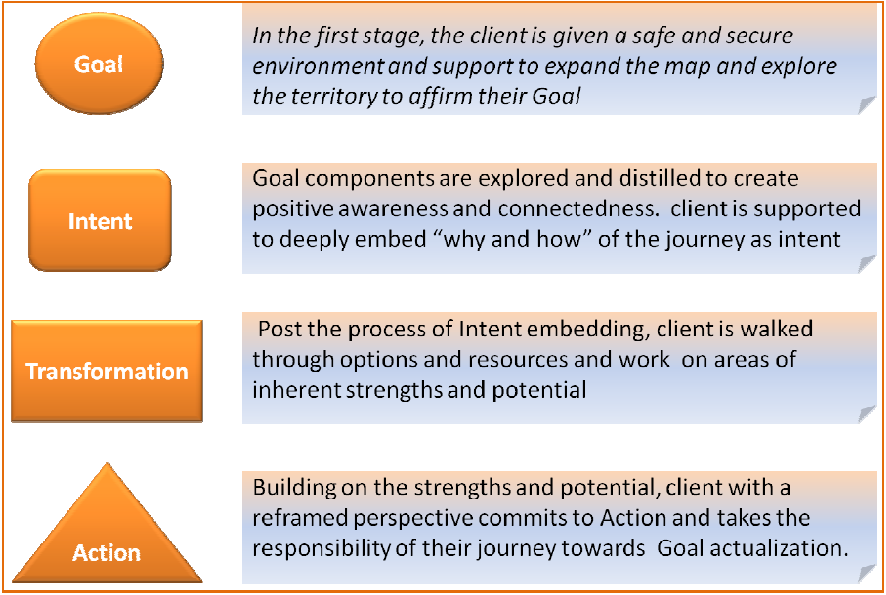A Coaching Model Created by Radhika M Menon
(Executive Coach, INDIA)
When I read the Bhagavad-Gita and reflect about how God created this universe everything else seems so superfluous. Albert Einstein
This model is deeply inspired by the great work of Bhagvad Gita, a significant part of the Epic, Mahabharata. http://en.wikipedia.org/wiki/Bhagvad_Gita
They say that:
A dream is a wish that your heart makes whenever you are fast asleep.
That might be a seed that germinates to a Goal. All of us wish for something or the other and most times the wish is left as it is. It takes something a bit more to convert that into a Goal. Fear of failure tops the list of a Gallop survey on what do people fear most. So, to view the territory and affirm one’s goal with reality intact, works to set the course of a coaching journey.
 Goal : /gə3l/noun. The object of a person’s ambition or effort; an aim or desired result:
Goal : /gə3l/noun. The object of a person’s ambition or effort; an aim or desired result:
Place my chariot, O Achyuta! Between the two armies that I see those who stand here prepared for war. On the eve of battle, (let me know) whom I have to fight. Verse: 23,Chapter 1, The Bhagvad Gita
In this model, once client is settled in the safe and comfort of the coaching space, s/he is encouraged to articulate the Goal, personal or professional. The client looks at the Goal from their present position and view. During the process, Client is encouraged to work on the visual of map versus the Territory and affirm their Goal.
Intent: /3n3t3nd/verb. Have (a course of action) as one’s purpose or intention; plan
On this path no effort is lost, nor is there any retrogression, even a little of this Dharma delivers from the great fear. Verse: 40, Chapter 3, The Bhagvad Gita
Once clarity of Goal is achieved, the second stage explores further to support the client in understanding why this goal is important. The objective of this stage is to deeply embed their Intent and delayer any underlying belief that might come in the way of their journey forward.
Deeply going into what would it mean to achieve this Goal can strengthen their Intent and pave way for the next step of Transformation.
Transformation: /transfə3me33(ə)n, tr33ns-, -nz-/noun. Marked change in form, nature, or appearance.
Beholding again thy gracious human form, O Janardhana I feel collected and in my wits and restored to my normal nature Verse: 51, Chapter 11, The Bhagvad Gita
From where the client is in present to where they want to get, components that need to be reframed, reorganized and reworked are carefully examined. The client is empowered with support to work on these components and windows to resources, external and internal support systems are opened out for exploration and utilizing the appropriate ones. Self awareness and awareness of what is around the ecosystem enables the client to work on transforming self and what is within their control to their advantage happen here. Components that are out of control are encouraged to be viewed from a different perspective that could work in favor and not against in their journey.
Action: /3ak3(ə)n/noun.[mass noun] the fact or process of doing something, typically to achieve an aim:
Destroyed is my delusion, I have regained through thy grace O Achyuta, I stand firm with my doubts dispelled. I will act according to Thy word Verse: 72, Chapter 18, The Bhagvad Gita.
Post the transformation, the client is ready to move forward and commit to action. Commitment carried forward from the last two stages propels the client to move through actions designed and owned by the client to reach the Goal destination. At the end of this cycle, the client and coach sets out with the next goal and follow through the process of the model. A combination of power tools and visualization techniques are used during each session to bring impact and influence in the coaching conversations.
Summary:
The model is crafted to affirm Goals and work on each of them through the process of understanding, affirmation, transformation and action.